 Do you use LinkedIn to find potential clients?
Do you use LinkedIn to find potential clients?
Want to use LinkedIn more effectively?
To grow your network, you need to build relationships and become an invaluable resource to others.
In this article you'll discover how to use LinkedIn to better connect with leads and prospects.
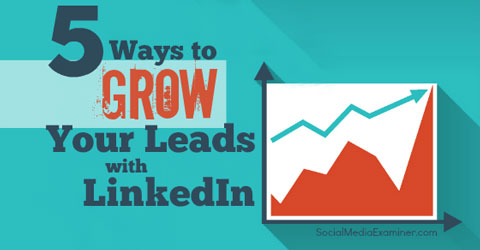
Listen to this article:
Where to subscribe: Apple Podcasts | Spotify | YouTube Music | YouTube | Amazon Music | RSS
#1: Optimize Your Profile
If you want to have success on LinkedIn, it's essential to have a profile that's professional, search-optimized and (most importantly) client-focused. In other words, your LinkedIn profile must speak to your ideal clients and tell them how you can help them.
First of all, make sure you use the same keywords in your profile that your ideal clients would input when doing a search for someone with your specialty. Don't be creative. Instead, be strategic in your choice of language.
For example, someone who's looking for a person to build them a new website might type “website designer” or “website developer” into the search. If that's a service you offer, then put those words in your LinkedIn profile.
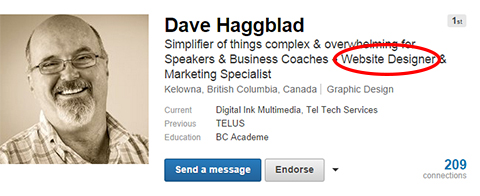
Choose up to three keywords and include them throughout your profile (in logical places and in professional ways).
Some of the most important places to include these keywords are in your:
- Headline
- Summary
- Current work experience (in the title and description)
- At least one past work experience (in the title and description)
- Skills
Being found in search results is important, but it's not everything. You also need to have a headline that makes people want to click on your profile. Once they get to your profile, you need an enticing summary.
Include the following in your summary:
- One to two paragraphs telling your story: who you are, why do you do what you do, what makes you credible
- Who your ideal clients are
- What problem your ideal clients face
- What solutions you offer to solve those problems
- Call to action: what you want them to do next (call, email, connect with you, etc.)
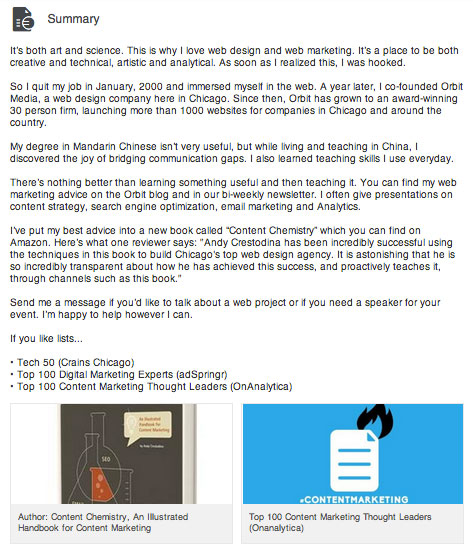
#2: Join LinkedIn Groups
LinkedIn groups are an excellent place to start to grow your network.
LinkedIn currently allows you to join up to 50 groups, so join as many as possible. The biggest mistake most people make is they join most or all industry-specific groups. It's fine to join a few to stay up to date on industry trends. However, the vast majority of the groups you join should be the ones your ideal clients are in.
Get World-Class Marketing Training — All Year Long!
Are you facing doubt, uncertainty, or overwhelm? The Social Media Marketing Society can help.
Each month, you’ll receive training from trusted marketing experts, covering everything from AI to organic social marketing. When you join, you’ll also get immediate access to:
- A library of 100+ marketing trainings
- A community of like-minded marketers
- Monthly online community meetups
- Relevant news and trends updates
The distribution of groups you join should look something like this:
- Groups that contain your ideal clients: 80%
- Special interest groups (i.e., personal and professional interest groups): 10%
- Industry groups: 10%
To locate potential prospects within each group, enter the group you want to prospect and click on the number of members, located in the top right-hand corner of each group. Scroll through the group members to see if there is someone you want to invite to connect.

LinkedIn will show all your first-degree connections in the group first and only list 500 members of the group. You may have to use the search box located at the top of the page to find other members who would make good prospects. Search for relevant keywords, job titles or locations.

Use the characteristics of your ideal client to search for and make new connections.
#3: Save Successful Advanced Searches
LinkedIn's advanced search tool is also great for finding potential prospects. It offers excellent functionality with the ability to search for people by keywords, relationship, groups, location and industry, which are all available with a free account.
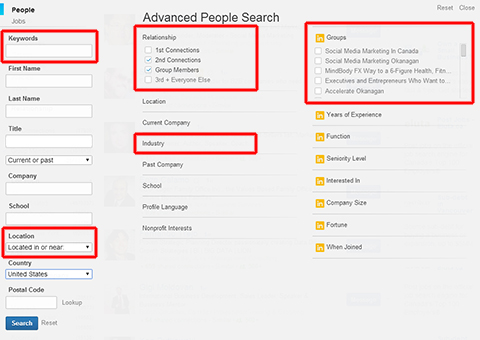
Along with filters, advanced search uses what is known as a Boolean search. This combines words and phrases with the words and, or, not and near to limit, widen or define your search. The people who come up will not always be perfectly targeted, but it will narrow your search down. Make sure to remove first-degree connections from your search parameters, since they are already part of your network.
If you find that a particular search is producing great results, save that search using the Saved Searches function.
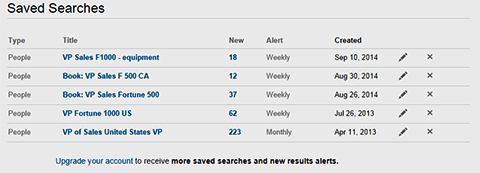
LinkedIn will send you an email once a week when someone fits the search criteria you set up. You can have up to three Saved Searches with a free account.
#4: Create a Sequence of Messages
It is not enough to just grow your network. Build a relationship with your new connections. Send a sequence of value-based messages to your prospects.
The Message

Discover Proven Marketing Strategies and Tips
Want to go even deeper with your marketing? Check out the Social Media Marketing Podcast! Publishing weekly since 2012, the Social Media Marketing Podcast helps you navigate the constantly changing marketing jungle, with expert interviews from marketing pros.
But don’t let the name fool you. This show is about a lot more than just social media marketing. With over 600 episodes and millions of downloads each year, this show has been a trusted source for marketers for well over a decade.
Always take the time to personalize each message appropriately before sending it. Use your connection's first name and add any details that will improve the message and make it feel more personal. The more individualized your messages, the better the results.
The purpose of the sequence of messages is to build a relationship with new connections and open up a dialog. When done right, this will establish you as an authority on your topic or niche. Plus, you'll become a valuable resource to your prospects.
While this may seem counterintuitive, none of these messages should include any of your products or services. It is extremely important that you do not include anything that could be perceived as spam or a sales pitch in your messages. This is the fastest way to kill any potential sale.
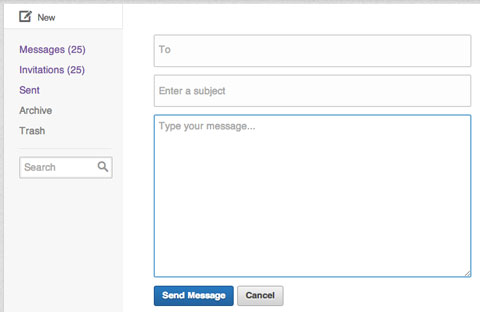
What the messages should include is information that would be considered valuable to your prospect. This includes links to relevant articles, checklists, white papers, case studies, reports, eBooks, videos or downloads. These resource materials can be ones you either created or curated, but they must be of professional quality and solve a pain point or help prospects make educated future decisions.
The Message Sequence
After your initial connection request, send a message thanking the person for connecting. If feasible, include one valuable resource in this first message.
Then, depending on your goals and industry, prepare one or two relationship-building messages to send out over the next couple of weeks. You can also send another resource or two, such as relevant stats or helpful tips.
After a couple of messages, if you feel like you have established some rapport, move the relationship offline. Suggest a phone call, Skype call or in-person meeting. No relationship with a potential prospect should be kept solely on LinkedIn—or on any online platform, for that matter.
If you want to turn a prospect into a client, a real conversation must take place. The only potential exception is if you're selling low-priced online products.
#5: Share Content With Your Network
Use LinkedIn to establish yourself as an industry expert and an invaluable source of information. Create and curate information that's of interest to your target market.
If you have the time and resources, create your own content to share. Write articles, shoot videos, etc. Even if you choose to produce your own material, you'll want to share content created by others as well.
There are many places you can look to find things to share. Just remember to always take the time to read through or watch any content before you share it to make sure it's high-quality and relevant to your audience.
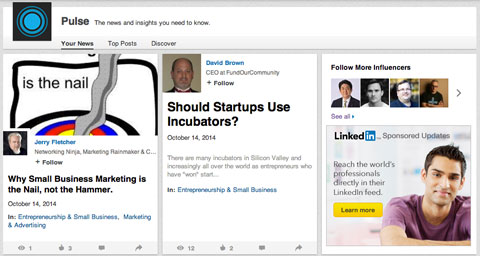
Here are a number of places to look for content:
- LinkedIn Pulse
- Related groups on social media sites
- Company blogs
- Newsletters of relevant online magazines, companies and experts
- Industry sites
Spend even a small part of your day searching relevant sites. That way you stay current with industry trends and news, and find articles to share with your network.
Post Status Updates and Share With LinkedIn Groups
Whenever you post an update, your connections will see it in their news feed and, depending on their settings, get it in an email. This keeps you top of mind and positions you as an expert in your field.
Posting in LinkedIn groups is another way to establish your credibility, while helping you build relationships with potential prospects within a group. Do not post promotional information about yourself or your business in groups. Many group owners will remove offenders from their group for this kind of behavior. Even if you're not removed from the group, you'll start to become known as a spammer, and your fellow group members will ignore your posts.
For both status updates and group posts, when you share a link to a post, it's important to add your own comment. Put the comment in the form of a question, since it's more likely to start a conversation. This is often a requirement when posting in groups, too.
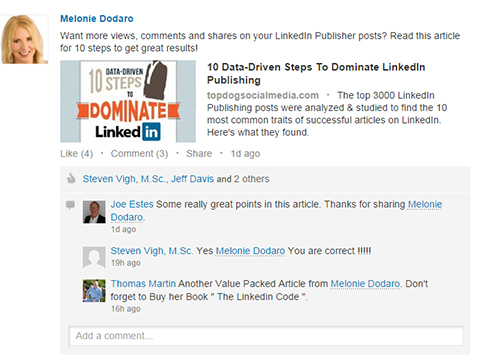
For example, when I shared an article called, “10 Data-Driven Steps to Dominate LinkedIn Publishing,” I added this: “Want more views, comments and shares on your LinkedIn Publisher posts? Read this article for 10 steps to get great results!”
LinkedIn Publisher
One other place to share content for the greatest return on your time and effort is on LinkedIn Publisher. It's an excellent platform to reach beyond your personal network. LinkedIn Publisher is similar to a blog, but has the ability to get you substantially more views and impact.
Conclusion
There are plenty of things you can do to use LinkedIn as a source for leads, clients and (eventually) income.
After you find a good prospect, send a connection request. I cannot stress enough that you MUST personalize the request and give your connections a reason to accept your invitation. You only have 300 characters, so your reason must be short and convincing.
If you dedicate time each day to completing these activities, you'll grow a valuable network filled with potential prospects. Build your relationships and become an essential resource to your prospects. As a result, you'll become their top choice when they are ready to make a purchase.
What do you think? How do you find prospects on LinkedIn? Where do you find content to share? In what groups have you found most leads? What's your top revenue-generating activity on LinkedIn? Share your tips in the comments.
Attention Agency Owners, Brand Marketers, and Consultants

Introducing the Marketing Agency Show–our newest podcast designed to explore the struggles of agency marketers.
Join show host and agency owner, Brooke Sellas, as she interviews agency marketers and digs deep into their biggest challenges. Explore topics like navigating rough economic times, leveraging AI, service diversification, client acquisition, and much more.
Just pull up your favorite podcast app, search for Marketing Agency Show and start listening. Or click the button below for more information.

